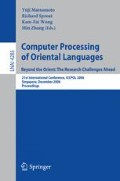Abstract
Techniques for find document clusters mostly depend on models that impose strong explicit and/or implicit priori assumptions. As a consequence, the clustering effects tend to be unnatural and stray away from the intrinsic grouping natures of a document collection. We apply a novel graph-theoretic technique called Clique Percolation Method (CPM) for document clustering. In this method, a process of enumerating highly cohesive maximal document cliques is performed in a random graph, where those strongly adjacent cliques are mingled to form naturally overlapping clusters. Our clustering results can unveil the inherent structural connections of the underlying data. Experiments show that CPM can outperform some typical algorithms on benchmark data sets, and shed light on its advantages on natural document clustering.
Access this chapter
Tax calculation will be finalised at checkout
Purchases are for personal use only
Preview
Unable to display preview. Download preview PDF.
References
Baker, L., McCallum, A.: Distributional clustering of words for text classification. In: Proc. of ACM SIGIR, pp. 96–103 (1998)
Bezdek, J.C.: Pattern recognition with fuzzy objective function algorithms. Plenum Press, New York
Bron, C., Kerbosch, J.: Finding all cliques of an undirected graph. Communications of the ACM 16, 575–577 (1971)
Cormen, T.H., Leiserson, C.E., Rivest, R.L., Stein, C.: Introduction to algorithms, 2nd edn. McGraw-Hill, New York
Cutting, D., Karger, D., Pedersen, J., Tukey, J.W.: Scatter/Gather: A cluster-based approach to browsing large document collections. In: Proc. of the 15th ACM SIGIR Conference, pp. 318–329 (1992)
Derenyi, I., Palla, G., Vicsek, T.: Clique percolation in random networks. Physics Review Letters 95, 160–202 (2005)
Dhillon, I.S.: Co-clustering documents and words using bipartite spectral graph partitioning. In: Proc. of the 7th ACM-KDD, pp. 269–274 (2001)
Ding, C.H.Q., He, X.F., Zha, H.Y., Gu, M., Simon, H.D.: A min-max cut algorithm for graph partitioning and data clustering. In: Proc. of IEEE ICDM, pp. 107–114 (2001)
Dorogovtsev, S.N., Mendes, J.F.F.: Evolution of networks. Oxford Press, New York
Jain, A.K., Murty, M.N., Flynn, P.J.: Data clustering: a review. ACM Computing Surveys 31, 264–323 (1999)
King, B.: Step-wise clustering procedures. Journal of the American Statistical Association 69, 86–101 (1967)
Krishnapuram, R., Joshi, A., Nasraoui, O., Yi, L.Y.: Low-complexity fuzzy relational clustering algorithms for web mining. IEEE Transactions on Fuzzy Systems 9, 595–607 (2001)
Liu, X., Gong, Y.: Document clustering with clustering refinement and model selection capabilitities. In: Proc. of ACM SIGIR, pp. 191–198 (2002)
Palla, G., Derenyi, I., Farkas, I., Vicsek, T.: Uncovering the overlapping community structure of complex networks in nature and society. Nature 435, 814–818 (2005)
Raghavan, V.V., Yu, C.T.: A comparison of the stability characteristics of some graph theoretic clustering methods. IEEE Transactions on Pattern Analysis and Machine Intelligence 3, 393–402 (1981)
Sneath, P.H.A., Sokal, R.R.: Numerical taxonomy: the principles and practice of numerical classification. Freeman, London
Steinbach, M., Karypis, G., Kumar, V.: A comparison of doucment clustering techniques. In: Proc. of KDD 2000 Workshop on Text Mining (2000)
Tsukiyama, S., Ide, M., Ariyoshi, H., Shirakawa, I.: A new algorithm for generating all the maximal independent sets. SIAM Journal on Computing 6, 505–517 (1977)
Zhao, Y., Karypis, G.: Criterion functions for document clustering. Technical Report #01-40, Department of Computer Science, University of Minnesota
Author information
Authors and Affiliations
Editor information
Editors and Affiliations
Rights and permissions
Copyright information
© 2006 Springer-Verlag Berlin Heidelberg
About this paper
Cite this paper
Gao, W., Wong, KF., Xia, Y., Xu, R. (2006). Clique Percolation Method for Finding Naturally Cohesive and Overlapping Document Clusters. In: Matsumoto, Y., Sproat, R.W., Wong, KF., Zhang, M. (eds) Computer Processing of Oriental Languages. Beyond the Orient: The Research Challenges Ahead. ICCPOL 2006. Lecture Notes in Computer Science(), vol 4285. Springer, Berlin, Heidelberg. https://doi.org/10.1007/11940098_10
Download citation
DOI: https://doi.org/10.1007/11940098_10
Publisher Name: Springer, Berlin, Heidelberg
Print ISBN: 978-3-540-49667-0
Online ISBN: 978-3-540-49668-7
eBook Packages: Computer ScienceComputer Science (R0)

